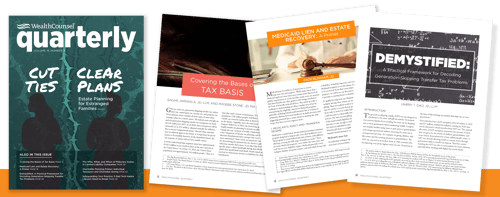
Written by Zach Bloxham, J.D
Medicaid pays for millions of Americans to receive long-term care and support.1 While many know that a Medicaid applicant must meet strict means-tested financial eligibility requirements to secure benefits, many more are unaware that these benefits are often granted with strings attached in the form of federally authorized liens.
This article provides a roadmap to understanding an often complex area of law by summarizing the eligibility criteria for Medicaid programs generally, outlining federal reimbursement law as it relates to permissive lifetime liens and mandatory at-death recovery, and suggesting practical tips to assist clients in meeting the challenges that these recovery regimes create.
I. Medicaid’s Asset and Transfer Regime
Medicaid is a needs-based, means-tested government assistance program designed to help people cover their healthcare costs. The program is a joint federal and state venture, with different offerings covering the full range of healthcare needs. There are many Medicaid programs, even within the same state, and each has its own eligibility regime. Medicaid generally covers indigent children, pregnant women, and individuals living with a disability, including long-term care institutionalization. For Medicaid recipients in certain classes, benefits paid are required to be recovered from their estate when they pass away. For our purposes, we will focus our discussion on Medicaid recovery as it pertains to nursing home or institutional programs.
To qualify for long-term care Medicaid, an applicant must navigate, among other criteria, an asset test and a prohibition on gifting. These two policies work in tandem, collaterally reinforcing one another to ensure that program resources are reserved for those truly in need. It is widely believed that a Medicaid program could not exist in a financially sustainable way without both policies. The asset test and gifting prohibition form the bedrock of the means-tested eligibility dynamic. The public policy consideration is easy enough to understand: The government does not want an individual to have a healthy amount of assets on a Monday, gift them to a neighbor on a Tuesday, and qualify for taxpayer-funded assistance on a Wednesday.
Medicaid’s Asset Test
CAn individual seeking to qualify for long-term care Medicaid must have resources below the applicable limit, which is $2,0005 for a single applicant in the vast majority of states. For a married couple, Congress allows a spouse at home, called a community spouse, to retain a greater share of assets while maintaining their sick spouse’s eligibility for benefits. Said differently, unmarried applicants have one limit, and married couples have a different one.
Medicaid regulations govern which assets are available, or countable, for purposes of the applicable asset limit. The general rule? Everything, with just a few exceptions, counts. This is true for both single and married individuals, with Medicaid treating a married couple as a single individual for eligibility purposes regardless of how ownership is actually titled. For example, a community spouse with a $100,000 bank balance, titled in their own name and always kept as separate property, not commingled with their spouse’s assets in any way, will find that asset countable for purposes of eligibility.
Federal law defines resources broadly; the term is intended to capture all that an individual or couple owns, with specific exemptions given to certain assets, often with conditions attached to the exemption. A primary residence may be exempt below a certain equity limit from the asset test if the single individual has declared an intent to return to the home if care at the nursing home is no longer required. This exemption also applies if the primary residence is occupied by a spouse or a minor or disabled child, with no equity limit cap.
Importantly, an asset (such as the primary residence) that is exempt for purposes of initial and continuing eligibility may not be exempt from Medicaid lien and recovery. In fact, exemption is expressly conditioned on the ability of the state to recover against the exempt asset when the recipient passes away, up to the total value of taxpayer expenditure on behalf of the decedent. Additionally, the transfer regime does not allow the Medicaid applicant to gift the exempt asset beyond a select class of individuals. An exempt asset, therefore, cannot generally be gifted without penalty.
Medicaid’s Gifting Prohibition
Medicaid’s transfer-of-asset regime reinforces the asset test by preventing Medicaid applicants and recipients from gifting assets that would otherwise be available for the individual to use to pay for . . .
Continue reading the full article for free by subscribing to the WealthCounsel Quarterly—the legal magazine for estate planning and elder law attorneys!




